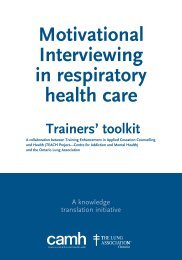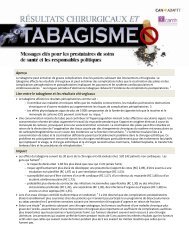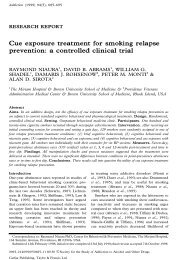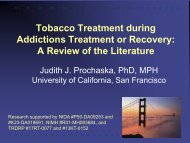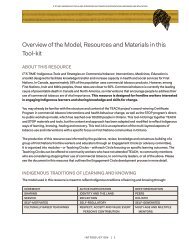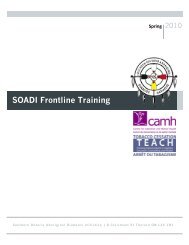Canadian Smoking Cessation Clinical Practice Guideline
Canadian Smoking Cessation Clinical Practice Guideline
Canadian Smoking Cessation Clinical Practice Guideline
Create successful ePaper yourself
Turn your PDF publications into a flip-book with our unique Google optimized e-Paper software.
CANADIAN SMOKING CESSATION GUIDELINEAll corporate hospital orientation programsshould include training to use brief smokingcessation interventions as well as informationon pharmacotherapy to support hospitalizedpersons who smoke.(Strength of Evidence = B)New Zealand Ministry of Health (2007) 14Provide brief advice to stop smoking to allhospitalized people who smoke. (Grade = A)Arrange multi-session intensive support,medication and follow up for at least 1 monthfor all hospitalized patients who smoke.(Grade = A)Briefly advise people awaiting surgery whosmoke to stop smoking and arrange support(such as NRT) prior to surgery. (Grade = A)All hospitals should have systems set up forhelping patients to stop smoking. Thisincludes routinely providing advice to stopsmoking and either providing a dedicatedsmoking cessation service within the hospitalor arranging for smoking cessation treatmentto be provided by an external service. (Grade= B)Advise parents and family members ofhospitalized children to stop smoking andoffer support to help them. (Grade = √)NRT can be provided to people withcardiovascular disease. However, wherepeople have suffered a serious cardiovascularevent (for example, people who have had amyocardial infarction or stroke) in the past 2weeks or have a poorly controlled disease,treatment should be discussed with aphysician. In these cases, oral NRT productsrather than patches are recommended as thepreferred option.(Grade = B)BACKGROUND<strong>Smoking</strong> is known to have a significant negativeimpact on risks associated with hospitalization;quitting smoking prior to admission has been shownto be beneficial for postoperative complication rates 18 .Hospitalization provides an ideal window ofopportunity to deliver smoking cessation services andsupports for patients. Moreover, patients admitted fora smoking-related reason may be more receptive tosmoking cessation interventions 19 . A recent Cochranereview has demonstrated that smoking cessationinterventions, which begin during hospitalization andcontinue for at least one month post-discharge areeffective 19 .Furthermore, with the prevalence of hospital smokefreepolicies on the rise, the provision of nicotinewithdrawal treatment and availability of smokingcessation services to patients is becoming increasinglyvital.A model of systematic hospital interventions forsmoking cessation, The Ottawa model, has been shownto be effective in increasing abstinence rates forpatients 20 and has been implemented in nearly 70 sitesacross Canada to date 21 .HOSPITAL-BASED POPULATIONS 22




